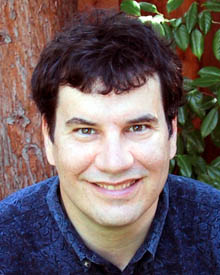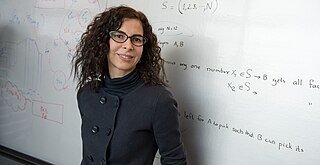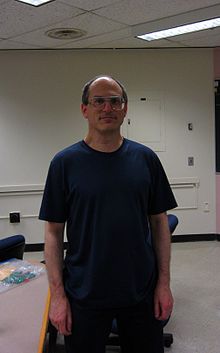SPICE is a general-purpose, open-source analog electronic circuit simulator. It is a program used in integrated circuit and board-level design to check the integrity of circuit designs and to predict circuit behavior.

Finite-difference time-domain (FDTD) or Yee's method is a numerical analysis technique used for modeling computational electrodynamics. Since it is a time-domain method, FDTD solutions can cover a wide frequency range with a single simulation run, and treat nonlinear material properties in a natural way.
Harmonic balance is a method used to calculate the steady-state response of nonlinear differential equations, and is mostly applied to nonlinear electrical circuits. It is a frequency domain method for calculating the steady state, as opposed to the various time-domain steady-state methods. The name "harmonic balance" is descriptive of the method, which starts with Kirchhoff's Current Law written in the frequency domain and a chosen number of harmonics. A sinusoidal signal applied to a nonlinear component in a system will generate harmonics of the fundamental frequency. Effectively the method assumes a linear combination of sinusoids can represent the solution, then balances current and voltage sinusoids to satisfy Kirchhoff's law. The method is commonly used to simulate circuits which include nonlinear elements, and is most applicable to systems with feedback in which limit cycles occur.
Placement is an essential step in electronic design automation — the portion of the physical design flow that assigns exact locations for various circuit components within the chip's core area. An inferior placement assignment will not only affect the chip's performance but might also make it non-manufacturable by producing excessive wire-length, which is beyond available routing resources. Consequently, a placer must perform the assignment while optimizing a number of objectives to ensure that a circuit meets its performance demands. Together, the placement and routing steps of IC design are known as place and route.
Delay calculation is the term used in integrated circuit design for the calculation of the gate delay of a single logic gate and the wires attached to it. By contrast, static timing analysis computes the delays of entire paths, using delay calculation to determine the delay of each gate and wire.
Electromagnetic field solvers are specialized programs that solve Maxwell's equations directly. They form a part of the field of electronic design automation, or EDA, and are commonly used in the design of integrated circuits and printed circuit boards. They are used when a solution from first principles or the highest accuracy is required.

Distributed amplifiers are circuit designs that incorporate transmission line theory into traditional amplifier design to obtain a larger gain-bandwidth product than is realizable by conventional circuits.
Giovanni De Micheli is a research scientist in electronics and computer science. He is credited for the invention of the Network on a Chip design automation paradigm and for the creation of algorithms and design tools for Electronic Design Automation (EDA). He is Professor and Director of the Integrated Systems laboratory at École Polytechnique Fédérale de Lausanne (EPFL), Switzerland. Previously, he was Professor of Electrical Engineering at Stanford University. He was Director of the Electrical Engineering Institute at EPFL from 2008 to 2019 and program leader of the Swiss Federal Nano-Tera.ch program. He holds a Nuclear Engineer degree, a M.S. and a Ph.D. degree in Electrical Engineering and Computer Science under Alberto Sangiovanni-Vincentelli.

A channel router is a specific variety of router for integrated circuits. Normally using two layers of interconnect, it must connect the specified pins on the top and bottom of the channel. Specified nets must also be brought out to the left and right of the channel, but may be brought out in any order. The height of the channel is not specified - the router computes what height is needed.
PathWave Design is a division of Keysight Technologies that was formerly called EEsof. It is a provider of electronic design automation (EDA) software that helps engineers design products such as cellular phones, wireless networks, radar, satellite communications systems, and high-speed digital wireline infrastructure. Applications include electronic system level (ESL), high-speed digital, RF-Mixed signal, device modeling, RF and Microwave design for commercial wireless, aerospace, and defense markets.
RF microwave CAE CAD is computer-aided design (CAD) using computer technology to aid in the design, modeling, and simulation of an RF or microwave product. It is a visual and symbol-based method of communication whose conventions are particular to RF/microwave engineering.
Spectre is a SPICE-class circuit simulator owned and distributed by the software company Cadence Design Systems. It provides the basic SPICE analyses and component models. It also supports the Verilog-A modeling language. Spectre comes in enhanced versions that also support RF simulation (SpectreRF) and mixed-signal simulation.
SpectreRF is an option to the Spectre Circuit Simulator from Cadence Design Systems. It adds a series of analyses that are particularly useful for RF circuits to the basic capabilities of Spectre. SpectreRF was first released in 1996 and was notable for three reasons. First, it was arguably the first RF simulator in that it was the first to be designed for large bipolar and CMOS RF circuits; it used shooting methods as its base algorithm; and it pioneered the use of Krylov subspace methods. The use of shooting methods gave SpectreRF remarkable robustness and the Krylov methods gave it capacity that was roughly 100 times greater than existing simulators at the time. Previously such simulators were designed to simulate very small GaAs integrated circuits and hybrids. These simulators were based on harmonic balance and could reliably simulate circuits with tens of transistors whereas SpectreRF could simulate circuits with thousands of transistors.

Kenneth S. Kundert is an engineer that is notable for his work in the area of Electronic Design Automation (EDA). He studied electrical engineering at the University of California, Berkeley under professors Alberto Sangiovanni-Vincentelli and Robert G. Meyer and received his doctorate in 1989. During this time, he created the circuit simulator that eventually became the Advanced Design System from what is now PathWave Design and the Spectre circuit simulator from Cadence Design Systems.

Farinaz Koushanfar is an Iranian-American computer scientist whose research concerns embedded systems, ad-hoc networks, and computer security. She is a professor and Henry Booker Faculty Scholar of Electrical and Computer Engineering at the University of California, San Diego.
The multilevel fast multipole method (MLFMM) is used along with method of moments (MoM) a numerical computational method of solving linear partial differential equations which have been formulated as integral equations of large objects almost faster without loss in accuracy. This method is an alternative formulation of the technology behind the MoM and is applicable to much larger structures like radar cross-section (RCS) analysis, antenna integration on large structures, reflector antenna design, finite size antenna arrays, etc., making full-wave current-based solutions of such structures a possibility.
Charles Albert Zukowski is a professor and former chair of the Department of Electrical Engineering at Columbia University. Zukowski was born in Buffalo, New York. While still a student at MIT, from 1979 to 1982, Zukowski worked at the Thomas J. Watson Research Center. He received his BS in electrical engineering from the Massachusetts Institute of Technology in 1982. He received the IBM PhD Fellowship from 1982 to 1985; in 1985 he earned his PhD in electrical engineering with a thesis entitled "Design and measurement of a reconfigurable multi-microprocessor machine". The same year, he joined the faculty of Columbia University as assistant professor, and was awarded tenure in 1993. Zukowski is an active member of IEEE and was made an IEEE Fellow in 2000. Zukowski's present research focuses on VLSI circuits and integrated circuit (IC) optimization, though in the past he has published in the fields of systems biology and computer architecture.
Lawrence Pileggi is the Coraluppi Head and Tanoto Professor of Electrical and Computer Engineering at Carnegie Mellon University. He is a specialist in the automation of integrated circuits, and developing software tools for the optimization of power grids. Pileggi's research has been cited thousands of times in engineering papers.
Signal Transition Graphs (STGs) are typically used in electronic engineering and computer engineering to describe dynamic behaviour of asynchronous circuits, for the purposes of their analysis or synthesis.

The method of moments (MoM), also known as the moment method and method of weighted residuals, is a numerical method in computational electromagnetics. It is used in computer programs that simulate the interaction of electromagnetic fields such as radio waves with matter, for example antenna simulation programs like NEC that calculate the radiation pattern of an antenna. Generally being a frequency-domain method, it involves the projection of an integral equation into a system of linear equations by the application of appropriate boundary conditions. This is done by using discrete meshes as in finite difference and finite element methods, often for the surface. The solutions are represented with the linear combination of pre-defined basis functions; generally, the coefficients of these basis functions are the sought unknowns. Green's functions and Galerkin method play a central role in the method of moments.






